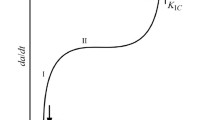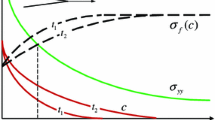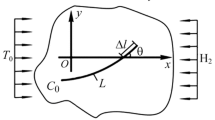Abstract
Analysis of hydrogen-stress field interactions have led to kinetic criteria for slow crack growth. Using both elastic and plastic stress fields under opening-mode loading, criteria for stage I, II, III growth are developed in terms of the pressure tensor gradient at the crack tip. It is proposed that stage I (stress-intensity dependent) growth kinetics are predominantly controlled by the elastic stress field while stage II (nearly stress-intensity independent) kinetics are controlled by the plastic stress field. Measurements of slow crack growth in cathodically-charged AISI 4340 steel verify the overall aspects of the correlation. Detailed measurement and analysis of the increase in crack-tip radius with increasing applied stress intensity have led to a proposed decrease in crack growth rate during stage II growth. Some experimental evidence corroborates this later hypothesis and is consistent with long range diffusional flow of hydrogen as the controlling mechanism for crack growth kinetics.
Similar content being viewed by others
References
A. R. Troiano:Trans. ASM, 1960, vol. 52, p. 54.
R. A. Oriani:Fundamental Aspects of Stress Corrosion Cracking, p. 32, Nat. Assoc. of Corros. Engrs., Houston, 1969.
C. St. John and W. W. Gerberich:Met. Trans., 1973, vol. 4, p. 589
W. W. Gerberich and Y. T. Chen:Met. Trans., 1975, vol. 6A, p. 271.
B. C. Syrett:Corrosion, 1973, vol. 29, no. 1, p. 23.
H. P. Van Leeuwen:ibid., no. 5, p. 197.
H. W. Liu:J. Basic Eng., ASME, 1970, vol. 92, p. 633.
R. P. Harrison, P. T. Heald, and J. A. Williams:Scripta Met., 1971,vol. 5,p. 543.
W. W. Gerberich:Hydrogen in Metals, p. 115, ASM, Metals Park, 1974.
A. J. Stavros and H. W. Paxton:Met. Trans., 1970, vol. 1, p. 3049.
W. G. Reuter and C. E. Hartbower:Eng. Fract. Mech, 1971, vol. 3, p. 493.
P. C. Paris and G. C. Sih:Amer. Soc. Test. Mater. Special Tech. Publ. 381, 1965, p. 30.
A. J. Wang:Quart. Appl. Mech., 1954, vol. 11, p. 427.
C. D. Beachem:Met. Trans., 1972, vol. 3, p. 437.
W. W. Gerberich and C. E. Hartbower:Fundamental Aspects of Stress Corrosion Cracking, p. 420, Nat. Assoc. of Corros. Engrs., Houston, 1969.
A. S. Tetelman and A. J. McEvily, Jr.:Fracture of Structural Materials, John Wiley and Sons, New York, 1967.
F. R. Coe and J. Moreton:Met. Sci. J., 1969, vol. 3, p. 209.
G. M. Evans and E.C.Rollason:J.Iron and Steel Inst., 1969, December, p. 1491.
A. J. Kumnick and H. H. Johnson:Met. Trans., 1974, vol. 5, p. 1199.
S. Mostovoy, H. R. Smith, R. G. Lingwall, and E. J. Ripling:Eng. Fract. Mech., 1971, vol. 3, p. 291.
H. L. Dunegan and A. S. Tetelman:Eng. Fract. Meck, 1971, vol. 2, p. 387.
C. S. Carter:Corrosion, 1969, vol. 25, no. 10, p. 423.
C. S. Carter:Corrosion, 1971, vol. 27, no. 11, p. 471.
V. J. Colangelo and M. S. Ferguson:Corrosion, 1969, vol. 25, no. 12, p. 509.
C. S. Carter:Eng. Fract. Mech., 1971, vol. 3, p. 1.
G. E. Kerns and R. W. Staehle:Scripta Met, 1972, vol. 6, p. 631.
W. D. Benjamin and E. A. Steigerwald: Air Force Materials Laboratory Report TR-68-80, 1968.
C. S. Kortovich and E. A. Steigerwald:Eng. Fract. Mech., 1972, vol. 4, p. 637.
J. M. Krafft and H. L. Smith: NRL Memo Report 2598, Naval Research Laboratory, Washington, April 1973.
W. A. Van Der Sluys:Eng. Fract. Mech., 1968, vol. 1, p. 447.
A. M. Sullivan:Eng. Fract. Mech., 1972, vol. 4, p. 65.
J. R. Rice and M. A. Johnson: inInelastic Behavior of Solids, M. F. Kanninen,et al, ed, McGraw-Hill, New York, 1970, p. 641.
J. R. Rice and D. M. Tracy: inNumerical and Computer Methods in Structural Mechanics, S. J. Fenves,et al., ed., Academic Press, New York, 1973, p. 585.
R. A. Oriani:Bunsen-Gesellshaft Phys. Chem., 1972, vol. 76, p. 848.
R. A. Oriani:Acta Met., 1974, vol. 22, p. 1065.
Author information
Authors and Affiliations
Additional information
Partial fulfillment of the M.S. Degree at the University of Minnesota
Rights and permissions
About this article
Cite this article
Gerberich, W.W., Chen, Y.T. & John, C.S. A short-time diffusion correlation for hydrogen-induced crack growth kinetics. Metall Trans A 6, 1485 (1975). https://doi.org/10.1007/BF02641960
Received:
DOI: https://doi.org/10.1007/BF02641960




